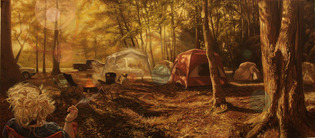Before images of Baby Jesus and family in their rustic shelter begin to overwhelm with sweetness and light, an exhibition in town seeks to remind us that the holy family would also have qualified under the current and far less joyful federal homelessness guidelines.
The dozen artists showing in the Parachute Factory’s current exhibition Out of House and Home individually may not be intending to offer a critique of the cozier aspects of the season. But brought together under one roof, the sobering show collectively does so, and is disquietingly effective.
If real estate is about location, location, location, maybe much of art’s meaning is about by timing, timing, timing.
Out of House and Home at 315 Peck St. in Erector Square features photography, sculpture, painting, and installations about the meaning of home and, therefore, homelessness. It runs through the coldest part of the year, finishing on Feb. 5.
Ron Dunhill’s enlarged inkjet photographs of makeshift homeless sites (at the top of the story) are among the most gripping.
Dunhill was formerly an animal tracker in Colorado. Dunhill is a nurse with Hill Health Center. His work involves locating and providing assistance to some of the more than 1,500 homeless people in Greater New Haven.
In the documenting photographs he has taken along his new pathways, he captures the splashes of color along with often elaborate domestic detail. Drapery, neatly arranged books, and other personal touches are valiantly attempts to transform a mattress and a flop under the highway into a home for the night.
What’s eerie about Dunhill’s work and many of the images in the exhibition is that the people are gone. For most of us the homeless are invisible until, of course, their desperation or illness results in a mugging or violent confrontation.
The absence of people also reflects the double entendre of the title, Out of House and Home: Economic, social, or health conditions sometimes far beyond anyone’s control can drive the subjects both there, and away. But where have they gone?
 Many are gone to enjoy the great outdoors, according to the scary David Lynch-inspired paintings of Roland Becerra. Tents and campgrounds have long been not only low-cost vacation spots, but also refuges for homeless families. Lynch’s hyper-photographic images lure you in and then unmask the fun.
Many are gone to enjoy the great outdoors, according to the scary David Lynch-inspired paintings of Roland Becerra. Tents and campgrounds have long been not only low-cost vacation spots, but also refuges for homeless families. Lynch’s hyper-photographic images lure you in and then unmask the fun.
There’s no Smokey the Bear around either to keep the kids from being pyromaniacs or to stop the painter’s wife from smoking and burning the forest down (bottom left).
If you’re drawn in by the beautifully rendered realism, reminiscent of the 3‑D stereopticon viewers from the quaint 1950s, you see what’s on view here is also a sense of failure and even shame. Isn’t that why one of the tents is diaphanous?
Co-curator Joy Pepe accompanied Becerra to this location at a Connecticut campground. She said lots of families were living there because they had no other options. She talked to teenagers who told her of their embarrassment.
By contrast, being comfortable in nature is the subject of Lucas Foglia’s startling, large-size photos of the back-to-nature folks at the Wildroots Homestead in North Carolina, which appeared in National Geographic. Living off of only what one can grow and rejecting all the superficial goods of this world would make for a more simplified holiday shopping season.
Yet the show is not as single-minded in its social critique as perhaps this particular viewer finds it. “We were thinking not only about homelessness, but what can become a home,” Pepe said.
 For example, the empty and forlorn, abandoned domestic dwellings in David Ottenstein’s black and white photographs have a formality and elegance that render the images a kind of perfect, if temporary, aesthetic home.
For example, the empty and forlorn, abandoned domestic dwellings in David Ottenstein’s black and white photographs have a formality and elegance that render the images a kind of perfect, if temporary, aesthetic home.
Then of course you blink and move on, for example to Elaine Kaufmann’s International Design. She spoofs the architecture magazines by putting on the covers of her faux publications not house beautiful but a sea of favelas.
Open the brochure, and the Swiftian take continues in the house beautiful lingo, “exotic bathrooms … invite us to indulge … our dreams” while the image is a primitive latrine.
Out of House and Home is the second of a two-part exhibition that explores what’s needed for people to survive and flourish. The first was White Collar, Blue Collar, Pink Slip. The Arts Council’s Debbie Hesse and Pepe curated, along with Steven Olsen and Kristina Zallinger, with coordination from Kyle Pederson of the Yale Program for Recovery and Community Health. The exhibition was prepared in partnership with Columbus House.
In January there will be a series of programs in connection with the exhibition and as a benefit for Abraham’s Tent, the 20 area congregations serving as overflow shelters for Columbus House this winter.
Pederson (that’s his son Alec in the mock geodesic dome) said federal homeless guidelines will provide those who qualify a bed only. “Food and clothing are extra.”

Wow. This looks fantastic. And necessary.